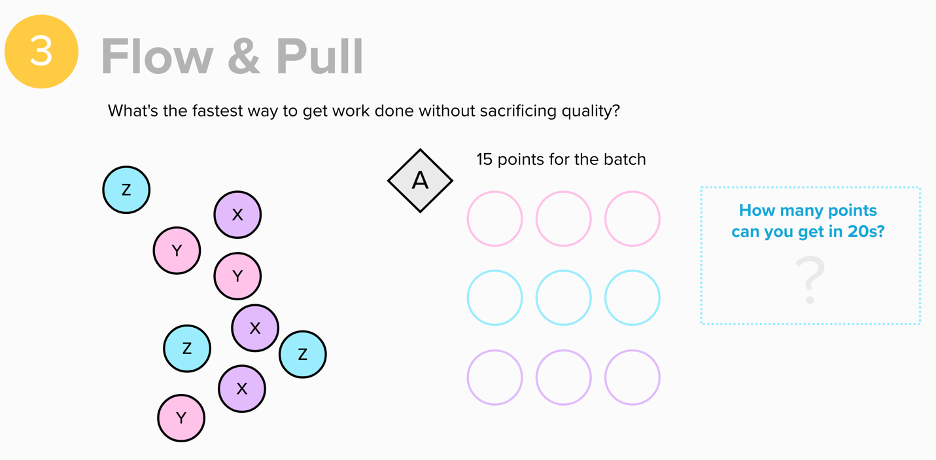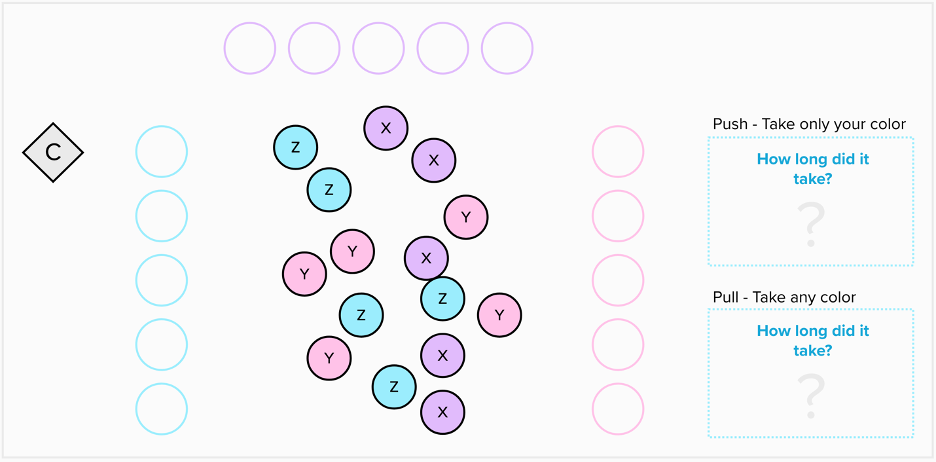While it seems much easier to demonstrate Kanban in a physical setting, there are plenty of ways to virtualize this experience.
Before we get into virtualizing, let’s remind ourselves of the in person simulations:
- Read about The Dice Game simulation
- Here’s a good reference of a bunch of Kanban simulations; most of these could be adapted easily enough to a virtual environment.
- Check out our Upcoming Trainings.
For an easy start, see this nice little free online simulator that lets you play with WIP limits and queue sizes and see the impact visually.
To illustrate some basic concepts for LitheSpeed’s Certified ScrumMaster class, I created a quick virtual exercise called Flow & Pull in Mural which illustrates how incremental deliveries can generate much higher return on investment through earlier delivery and accrual of value:
- Large batch transfer – Time how long it takes to finish the entire batch. How much profit would you make in 60s if every second it’s on the market made you $3,000?
- Small batch transfer – Time how long it takes to finish each batch. How much profit would you make if every second a release is on the market made you $1,000?
For an easy virtualization, you could simulate classics like the penny exercise something like this:
- Form groups of three in a breakout room
- Person A: Gather ten coins
- Person B: Prepare a timer
- Person C: Score results, 10 points per coin delivered
- Round 1 – Big Batch flow, waterfall-style
- Person A – Turn all coins over, then over again. Credit only when all coins are done.
- Person B – Call out five-second warning.
- Person C – Record total score when time runs out (probably zero).
- Round 2 – WIP Limit of 3
- Person A – Turn three coins over, then over again. Credit when a group of three are done.
- Person B – Call out five-second warning.
- Person C – Record total score when time runs out.
- Round 3 – WIP Limit of 1
- Person A – Turn one coin over, then over again. Credit when each coin is done.
- Person B – Call out five-second warning.
- Person C – Record total score when time runs out.
- Debrief:
- How stressful was each round? Why?
- What were the pros and cons of each WIP limit?
Other ideas to get a deeper Kanban simulation:
- Have multiple steps in the process across different people, apply different WIP limits for each step
- Have someone draw a cumulative flow diagram based on some data
- Show a cumulative flow diagram and have people interpret 2-3 questions using it
- Show a series of Kanban boards and quiz people on what’s happening (e.g. where’s the bottleneck? Where is the WIP limit too low or high?). You could use a tool like Mentimeter or Kahoot to gamify it as well.
While these are just some quick thoughts, hopefully they spark some ideas about how to enhance your training acumen and variety. If you have a particular topic you’d like us to explore delivering either virtually or in person just reach out and let us know, and we’ll share our ideas there as well!



Arlen Bankston is a Certified Scrum Trainer and CoFounder of LitheSpeed.
Join Arlen in Advanced Scrum training to learn more team facilitation tips and tricks.

